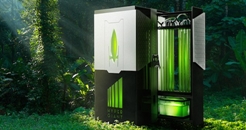 Capturing more carbon
Capturing more carbon
From articles on Singularity and Good News Network
Two initiatives that will help remove carbon from the atmosphere:
500 billion new trees
A new study conducted by researchers at Switzerland’s ETH-Zürich, published in Science, details how Earth could support almost an additional billion hectares of trees without the new forests pushing into existing urban or agricultural areas. Once the trees grow to maturity, they could store more than 200 billion metric tons of carbon.
The ETH-Zürich research team combined Google Earth mapping software with a database of nearly 80,000 existing forests to create a predictive model for optimal planting locations. In total, 0.9 billion hectares of new, continuous forest could be planted. Once mature, the 500 billion new trees in these forests would be capable of storing about two-thirds of the carbon we have emitted since the industrial revolution.
Other researchers have noted that the study may overestimate how efficient trees are at storing carbon, as well as underestimate how much carbon humans have emitted over time. However, all seem to agree that new forests would offset much of our cumulative carbon emissions.
However there is a challenge in remote locations. Technology can speed up the planting process, including a new generation of drones that take tree planting to the skies. Drone planting generally involves dropping biodegradable seed pods at a designated area. The pods dissolve over time, and the tree seeds grow in the earth below.
Planting the trees is the first step in a long road toward an actual forest. Companies are leveraging artificial intelligence and satellite imagery in a multitude of ways to increase protection and understanding of forested areas. The approach can lead to faster identification of threats like pest infestation and a better understanding of the state of forests. AI can also play a pivotal role in protecting existing forest areas by predicting where deforestation is likely to occur. Networks of sensors can provide detailed information about the state and needs of trees.
However, much of the positive impact that said trees could have on carbon levels in the atmosphere is likely decades away.
And few of the proposed new forests will likely succeed without ensuring that people living in and around the areas where reforestation takes place become involved, and can reap rewards from turning arable land into forests.
Read the full article here.
Government are backing efforts by The Woodland Trust to plant 64 million trees in UK over next 10 years. Schools, communities, businesses, individuals needed! See Woodland Trust.
Bioreactor to capture carbon
A team of innovators has come up with an ingenious new bioreactor that uses algae to capture and process carbon from the atmosphere. Measuring in at just 3 by 3 feet wide and 7 foot high, the compact device captures as much carbon dioxide as an acre of trees.
The Eos Bioreactor, which was developed by US Texas Austin-based tech company Hypergiant Industries, uses AI to optimize algae growth, carbon capture, and algae output.
Since algae is 400 times better at sequestering carbon than trees, the reactor can process about two tons of oxygen in a year, which is about the same as an acre of trees. Algae is a single-celled organism that is “considered one of nature’s most efficient machines” because of its ability to multiply rapidly through the absorption of sunlight and carbon dioxide. Not only that, it can be grown nearly anywhere and requires very few nutrients to survive.
As the algae consumes CO2, it also produces biomass, which can then be harvested and processed to create fuel, oils, nutrient-rich high-protein food sources, fertilizers, plastics, cosmetics, and more.
With machine intelligence, the designers improved the efficiency of their design to use autonomous health monitoring for a machine that is aware of—and can react to—its surroundings.
Hypergiant plans to release the blueprints for the bioreactor to the online maker community later this year with the goal of empowering individuals to create similar, smaller and modular devices for use in residential units.
Read the full article here.
A pioneering opportunity to demonstrate environmental responsibility in your community?
Retweet about this article:
From articles on Singularity and Good News Network, 15/10/2019